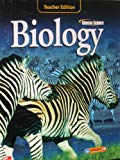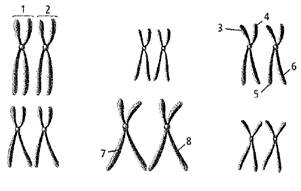
Concept explainers
Introduction:
Reproductive cells which pass on genetic traits from the parent to child are produced by the process of meiosis. In order to maintain the same number of chromosomes in each generation, an organism produces gametes. Gametes are sex cells and have half the number of chromosomes.
Answer to Problem 4STP
Correct answer :
The correct answer is option B. 6
Explanation of Solution
Explanation/justification for the correct answer:

Option B. 6 −During metaphase of meiosis I, pairs of homologous chromosomes line up at the equator of the cell. During anaphase I the homologous chromosomes separate and move to opposite poles of the cell. At the end of meiosis I, the daughter nuclei have half the number of chromosomes. One chromosome from each pair of homologous chromosomes enters the daughter cell. In the given organism there are six pairs of chromosomes. Therefore, at the end of meiosis I there will be only six chromosomes.
Hence, this is the correct option.
Explanation for incorrect answer:
Option A. 3- At the end of meiosis I the daughter nuclei have half the number of chromosomes. One chromosome from each pair of homologous chromosomes enters the daughter cell. In the given organism, there are six pairs of chromosomes. Therefore, at the end of meiosis I there will be only six chromosomes.
Hence, this is not the correct option.
Option C. 9- At the end of meiosis I the daughter nuclei have half the number of chromosomes. One chromosome from each pair of homologous chromosomes enters the daughter cell. In the given organism, there are six pairs of chromosomes. Therefore, at the end of meiosis I there will be only six chromosomes.
Hence, this is not the correct option.
Option D. 12- At the end of meiosis I the daughter nuclei have half the number of chromosomes. One chromosome from each pair of homologous chromosomes enters the daughter cell. In the given organism there are six pairs of chromosomes. Therefore, at the end of meiosis I there will be only six chromosomes.
Hence, this is not the correct option.
Chapter 11 Solutions
Glencoe Science Biology, Teacher Edition, Hardcover Book Only
Additional Science Textbook Solutions
Brock Biology of Microorganisms (15th Edition)
Campbell Essential Biology (7th Edition)
Physics for Scientists and Engineers: A Strategic Approach, Vol. 1 (Chs 1-21) (4th Edition)
Chemistry: The Central Science (14th Edition)
Biology: Life on Earth (11th Edition)
Introductory Chemistry (6th Edition)
- Describe the principle of homeostasis.arrow_forwardExplain how the hormones of the glands listed below travel around the body to target organs and tissues : Pituitary gland Hypothalamus Thyroid Parathyroid Adrenal Pineal Pancreas(islets of langerhans) Gonads (testes and ovaries) Placentaarrow_forwardWhat are the functions of the hormones produced in the glands listed below: Pituitary gland Hypothalamus Thyroid Parathyroid Adrenal Pineal Pancreas(islets of langerhans) Gonads (testes and ovaries) Placentaarrow_forward
- Describe the hormones produced in the glands listed below: Pituitary gland Hypothalamus Thyroid Parathyroid Adrenal Pineal Pancreas(islets of langerhans) Gonads (testes and ovaries) Placentaarrow_forwardPlease help me calculate drug dosage from the following information: Patient weight: 35 pounds, so 15.9 kilograms (got this by dividing 35 pounds by 2.2 kilograms) Drug dose: 0.05mg/kg Drug concentration: 2mg/mLarrow_forwardA 25-year-old woman presents to the emergency department with a 2-day history of fever, chills, severe headache, and confusion. She recently returned from a trip to sub-Saharan Africa, where she did not take malaria prophylaxis. On examination, she is febrile (39.8°C/103.6°F) and hypotensive. Laboratory studies reveal hemoglobin of 8.0 g/dL, platelet count of 50,000/μL, and evidence of hemoglobinuria. A peripheral blood smear shows ring forms and banana-shaped gametocytes. Which of the following Plasmodium species is most likely responsible for her severe symptoms? A. Plasmodium vivax B. Plasmodium ovale C. Plasmodium malariae D. Plasmodium falciparumarrow_forward
 Human Anatomy & Physiology (11th Edition)BiologyISBN:9780134580999Author:Elaine N. Marieb, Katja N. HoehnPublisher:PEARSON
Human Anatomy & Physiology (11th Edition)BiologyISBN:9780134580999Author:Elaine N. Marieb, Katja N. HoehnPublisher:PEARSON Biology 2eBiologyISBN:9781947172517Author:Matthew Douglas, Jung Choi, Mary Ann ClarkPublisher:OpenStax
Biology 2eBiologyISBN:9781947172517Author:Matthew Douglas, Jung Choi, Mary Ann ClarkPublisher:OpenStax Anatomy & PhysiologyBiologyISBN:9781259398629Author:McKinley, Michael P., O'loughlin, Valerie Dean, Bidle, Theresa StouterPublisher:Mcgraw Hill Education,
Anatomy & PhysiologyBiologyISBN:9781259398629Author:McKinley, Michael P., O'loughlin, Valerie Dean, Bidle, Theresa StouterPublisher:Mcgraw Hill Education, Molecular Biology of the Cell (Sixth Edition)BiologyISBN:9780815344322Author:Bruce Alberts, Alexander D. Johnson, Julian Lewis, David Morgan, Martin Raff, Keith Roberts, Peter WalterPublisher:W. W. Norton & Company
Molecular Biology of the Cell (Sixth Edition)BiologyISBN:9780815344322Author:Bruce Alberts, Alexander D. Johnson, Julian Lewis, David Morgan, Martin Raff, Keith Roberts, Peter WalterPublisher:W. W. Norton & Company Laboratory Manual For Human Anatomy & PhysiologyBiologyISBN:9781260159363Author:Martin, Terry R., Prentice-craver, CynthiaPublisher:McGraw-Hill Publishing Co.
Laboratory Manual For Human Anatomy & PhysiologyBiologyISBN:9781260159363Author:Martin, Terry R., Prentice-craver, CynthiaPublisher:McGraw-Hill Publishing Co. Inquiry Into Life (16th Edition)BiologyISBN:9781260231700Author:Sylvia S. Mader, Michael WindelspechtPublisher:McGraw Hill Education
Inquiry Into Life (16th Edition)BiologyISBN:9781260231700Author:Sylvia S. Mader, Michael WindelspechtPublisher:McGraw Hill Education





